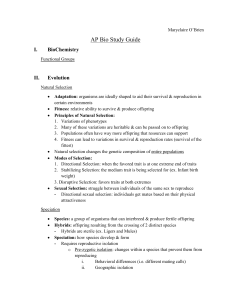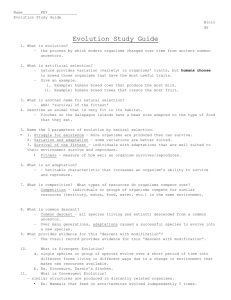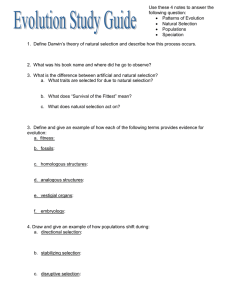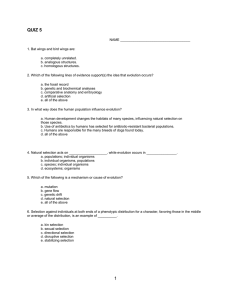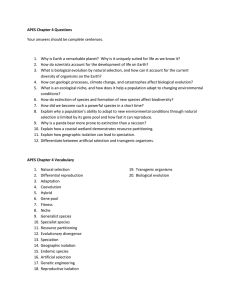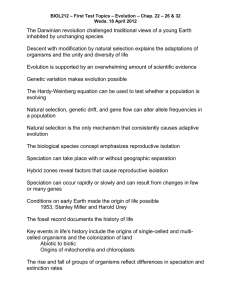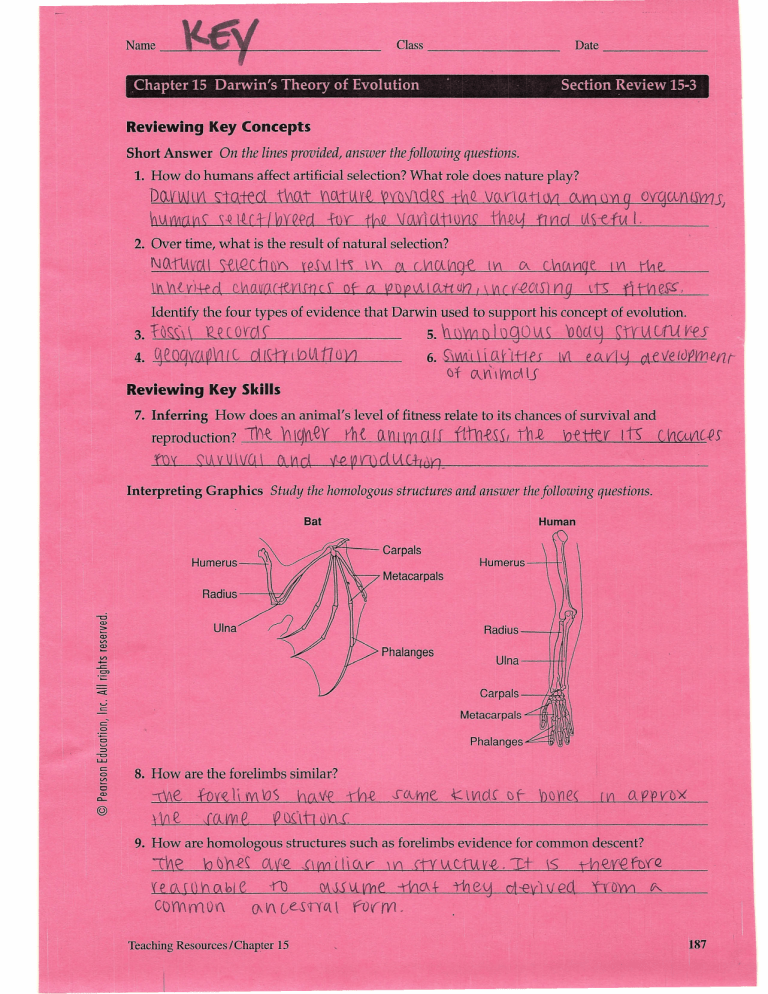
Class
Chapter 15 Darwin's
Reviewing
_
Theory of Evolution
'
Date
~
Section Review 15-3
Key Concepts
Short Answer On the lines provided, answer the following questions.
1. How do humans affect artificial selection? What role does nature play?
bOXlAllv\ ~tQ±ed t\t\Qt Y\QtlA vt \,)\{\)\f'\dQ.S tY\~ VOX'latJ Wl OvM G¥l 9 OYq(MHStYlS}
hUY\1tH1<' S-QI·tell ~yeecJ fnt= tho Vail CAtHWlS th.e;y fI Vie( vt~-efu I.
2. Over time, what is the result of natural selection?
NOd1AVcA\ \-f,\QC{]I)Y,,\ teSvt\ti
\\'\V\tvl+ed cJAOlfOCitY1Cf/cf Of
\V\
(J
CA CVlCUflg-e.
WDy>vtlO,,;tt<Jn
lV\
I
C\1CAVlqt
C\.
IV\
vts
"'fie (-eOtSlng
ti1fc
tltiJeff,
Identify the four types of evidence that Darwin used to support his concept of evolution.
3.
4.
:fOs.<;\\ R£ (Ora r
5.
~eoqva~v]((, oIl0:ylblAnoVJ
n l)¥vl DIogo \AS
6.S\wtl\jCAY!fjef
()f
Reviewing
C\.v\', mo\
'DOelY RtnA uru V'€5
elXvly ~eVelcJem~n,
1v1
IS
Key Skills
7. Inferring How does an animal's level of fitness relate to its chances of survival and
reproduction?l'Vlk. VI\gn~Y Yh{ D.VlI WI fS fttYl-e-ss, rn.Q, 'o-etteV' Its" CJIJ.CWlC(>S
a
fn,{
S'\AVV\VGl,I
'/£ ~ruclViC+ton_
CU'\d.
Interpreting Graphics Study the homologous structures and answer the following questions.
Bat
Human
.//'ie"+--
Carpals
Humerus
Humerus
Metacarpals
Radius ----\\'t-71J1/
Ulna
Radius --+-+1
Phalanges
Ulna
---++-ftl
Carpals -~~
\
Metacarpals
Phalanges
8. How are the forelimbs similar?
@
--0Ae
fpl{((,l\ M \as
\1n e
. JClVYl e,
ha:Vf
=tio..e
SOvWle.
.t.\VlQf
Df-
UOYle<
(V\
o..pevo'X
e lK\tJ 0hS
9. How are homologous structures such as forelimbs evidence for common descent?
:t\t\e
\obb~~ 011[~ JH'VliljCAV"
Teaching Resources/Chapter
15
\V) ,~JY\ACAJAy.e,.:r+ \S
t110r€fu,{Q
187
Class
Chapter 16 Evolution of Populations
_
Date~
, .
_
Section Revi~w 16-3
Reviewing Key Concepts
On the lines provided, answer the following questions.
Short Answer
1. When are two species said to be reproductively
SV~cJ-e\
o.XlQ
ro
--\'ol-ld
feprOd.V\C.tlVf.lY
'o€
2. Describe the three forms of reproductive
4
B-e\t\
" Te
CA\fl D'y(J\\ - <1I\(;S \ hi \
Yl'q?\)(C(
I-
w\JtYJ
isolated?
vJhen
\~olatecl
isolation.
\(i\¥
C O\AlftS\t\
cA tffl
V\f2 £11
\'€
'(\t\t\0\ 11 \) Y
'£ 0 P\A. 1 n
t
ntlVl S
-YJm-es Identifying
Processes On the lines provided, use the numbers 1-6 to indicate the
order in which the following events occurred in the speciation of the Galapagos
finches.
'3
3. changes in the gene pool
4. continued
\
5. founders
evolution
arrive
6. reproductive
isolation
7. separation
of populations
8. ecological
competition
Reviewing Key Skills
9. Applying Concepts Describe a situation that would result in the
sudden geographic isolation of a few members of a population.
'(e~\AIt frOm
C\ new
()oo1y
\l\l CAti y= tnym =ec{
cA lA r \ Y19 Q, f1 0 acA ) 1=\1P. ye, ro Uti Vl9 ulf(lYe \f C"Y
(,1,1\C1 nq-e ( in
(VtYldfnYYb
r frDYVl e cLtti, q IAOt.t:-€.f'
'-'
=
C1eogrC4.~h·((j
c:
o
of
~
'-'
-==>
(j(
\£.()IQt}Oh
()\A
let
LL.I
c:
o
~
""
c...
<1>
@
y= hLM'\I!
C2
0< n
01e.ve I 0 ¥'
yY) £.11
t=
10. Inferring Suggest one reason that natural selection on the
Galapagos Islands produced species that were quite different from
the ancestor species on the mainland.
-rV\e QI\el!
hUM
hequ
mer\'"
("onCftDIj'nf
on
t\) f~5)
ct\o\-e
aen
L
CQit1>YS'j
Ct the
1.A)'\Qkv
ro\A
me
th£
c! (ffe"VWr
VlC1£YJ W-€('f
{;I.rJ?:fe ffit\t
t11.e IfICtVlofJ'}r1lffiV':oot
-rl1Cty- q-(;~.e5· ro
Teaching Resources / Chapter 16
__
ey\L\~ r
nexT
CnV\rOVlm~Y\ta.(
IVld/victVnlsq-e,Y'l~rCi\.
Hun.
W-eve
199
Name_\«...J
__
Class
Date
_
Chapter 15 Darwin's Theory of Evolution
_
Chapter Vocabulary Review
On the line provided, write the letter of the definition that best
matches each term on the left.
Matching
A
D
1. evolution
a. change over time
2. fossil
b. differences among individuals
3. natural variation
c. preserved remains of an ancient organism
4. struggle for existence
d. survival of the fittest
5. fitness
e. all species are derived from common ancestors
6. adaptation
7. natural selection
f. structures that develop from the same embryonic
tissues, but have different mature forms
8. common descent
g. ability of an individual to survive and reproduce
9. homologous
within a species
in a specific environment
structures
h. organ with little or no function
10. vestigial organ
i. competition for food, space, and other resources
among members of a species
j. inherited characteristic that increases an
organism's chance of survival
Terms On the lines provided, write a definition for each of the
Defining
following terms.
~ J {, ) e X P CC\b &\tJ l) Yl D~ P b ~ V\ om -eft "'th 0\;1- hCAV'-Q OCL\A rYi'C\ 11\ 11fI£ notiJ;t rct\ W oy ld.
12. artificial selection 0 CC \A V ~ vv hf> Y\ h \/l. tv\ ct Yl S S Ble.C t n C'Lt}t ra. lllj
e c c lJ\ n VHo) V CAyf 0\ h dne mat
-tit!..e q ¥1 Vl d uti"t ht l .
11. theory
CA VV..e1\ - SIA Q pO\" t-t' c{.
13. survival of the fittest I ~
or <;\""')11.5 m f\Je~t
ex.
r hCAS
r(aD\·t
\2 Yl Vlt\ Le.
a.C(CA}?tt ct
14. d~s~Jht~ttmJSfi\c1gtLye~YutA
r ,(?'f.cl f
,tt $; tJil
(k<'-S'ce-tloLP'L
'!l
UC
ti1 ~,\ Y
1m e \ r ~ S" that-eMVl y\lh mtrv~
. , / MUAJttC
wltb
dl\l).
tl\q,t eaCh
@
WLll
~
g
/1 VI VI '1
~
t11
os-e
a
V)9£f) f:(oM (\tiaE''!''''
If£C IQJ ~.
C)'/lQ;V'
-h V{I'le- •
Multiple Choice On the line provided, write the letter of the answer that best
~
J>
completes the sentence.
A--'-15. Cows
------.,F-
"))
that give more milk than other cows are an
example of
a. natural variation.
c. survival of the fittest.
b. natural selection.
d. struggle for existence.
16. The practice of breeding dogs to produce offspring
with specific traits is an example of
188
a. natural variation.
c. common descent.
b. natural selection.
d. artificial selection.
Teaching Resources/Chapter
15
.Narne_~
Class
__
Date
_
_
17. Natural selection is the same as
G
a. struggle for existence.
c. artificial selection.
b. survival of the fittest.
d. descent with modification.
18. The diagrams of the limbs below show evidence of
a. natural variation.
c. common descent.
b. natural selection.
d. artificial selection.
Turtle
A
Alligator
Bird
Mammals
19. The bones in the diagram above are examples of
_-----'A--'- __
a. homologous structures.
c. adaptation.
b. fitness.
d. struggle for existence.
20. A human's appendix and a skink's legs are examples of
Short Answer
a. vestigial organs.
c. natural selection.
b. fitness.
d. artificial selection.
On the lines provided, answer the following questions.
21. How did Darwin interpret the fossil record?
QrbvlQect
"foSS'\\S
01- cAl ffl.Y'-e n t
Q\
It
k
o\-e-to.ll-ect
fo y m $'
I)
Y.QCOyd
me,
o'F-
vex- £cvvt1t1 r
19yt
<
~'V(fl(.,tl1fu
9
ku,s 'tu yY
22. What conditions force organisms to compete in a struggle for existence?
t1lq'lt!
bw-t1a
tVlCl±
ve f{,!•.l,l ~
(ems
l..fete.!
To
Ictrqe
Y'tltentiQllY
vy\ OIJ\e- Y'-eS 0 \A/V ( e 5' t1A
t1'le.M
u//I\
23. How do successful adaptations improve an organism's fitness?
.f V\c;v\1~
0 V~ CNVtl S IfYtS·:to
'eY\\j\YOY\r\t\%t
@
~,vtct. 1'h\1£
beL
om €..
~-.ej;1e r
oeMe,V"ct.t?Ie.
ro;,?u,ICAt1Ol1s
cuV'f
a VC\ 1 I a. ~ l-€.
.11)
~
Wle-e..+
",,1 tep{
~\AyVI v"t
,to
~v
t1J
a,Vld
Vl~..pds_
+hQ..\ y
&4Y\lc-lvtU;
24. What does descent with modification imply about the relationships among
the different species on Earth today?
\) -eSG-evl,...
'w t titl
r \1eLter Y\ os«
Y\100\'\ f1LCl OJh
to 0\ C4 LOrn m oyl
Teaching Resources! Chapter 15
I
l
Vl'\101 \ e I
.,...ha :t TO c{ cuy (5'
(AV\(,e~IdY-!
\\1
me
I I'Ye fIeVlt-'
otrS-mrt 1:- P£Ut
0(
189
Nmne
~
_
Class
_
Chapter 16 Evolution of Populations
Date
_
Chapter Vocabulary Review
Completion On the lines provided, complete the following sentences.
1. The combined genetic information of all members of a particular population
9we. £to l
is called a(an)
2. The te:\Q1\\/e -\yeqUeno ..l
of an allele is the number of times thatthe allele
occurs in a gene pool, compared with the number of times other alleles occur.
3. A(an)
r
4~~\Dk
t "ral",
-
·ita (ts
is a trait controlled by a single gene.
are controlled by two or more genes.
1J~®WW
5. The r~\Q\hIe
by a percentage.
of an allele in a population is often represented
Multiple Choice. On the line provided, write the letter of the answer that best
compl~s
A
, I
I
the sentence or answers the question.
6. For most genes, a gene pool typically contains
a. no alleles.
c. one allele.
b. two or more alleles.
d. no more than two alleles.
7. The graphs below show changes in the distribution of beak size in Galapagos
finches during a period when food was scarce. What type of natural selection
do the graphs show?
c. stabilizing selection
a. directional selection
d. disruptive selection
b. destabilizing selection
C/)
C/)
"Ec
"E
m~
_rn
.- 0
-co
0-
~a.
CIl 0
.00..
E
::J._c
~a.::J
CIl 0
.00..
E
c::
::J._
/
c::
(1):;=
.- 0
0::J
Peak shifts; average
beak size increases.
Z
Beak Size
•
Z
---1.~
\
I
I
I
I
I
I
@
I
/
Beak Size
---1.~
8. The graph below shows the distribution of human birth weights. What
type of selection keeps this curve narrow and in the same place?
a. directional selection
c. stabilizing selection
b. destabilizing selection
d. disruptive selection
c
o
~
Selection
against
both extremes
keeps curve
\ narrow and in
\ same place.
"5
a.
o
a..
o
CIl
Ol
co
i
C
!
h
CIl
~
rf
,
/
Birth Weight
<.,
.
200
\
CD
VI
D
•
Key
Low mortality,
high fitness
High mortality,
low fitness
<,
---------~)o
Teaching Resources I Chapter 16
co
<:
Cl>
=-
Name
_
D
-0
Q.)
:>
Q;
V'>
A
e
~
-=
.=
<C
•....
<::
r=;'
C>
-..:::
c
•....
-=
:::;0
u....o
<::
~
c
Q)
c....
@
D
Class
_
Date
_
9. What type of natural selection takes place when
individuals at the upper and lower ends of the curve
have higher fitness than individuals near the middle?
a. directional selection
c. stabilizing selection
b. destabilizing selection
d. disruptive selection
10. A random change in allele frequency is called
a. fitness.
c. speciation.
b. genetic drift.
d. the founder effect.
11. Genetic drift is more likely to occur in
a. large populations.
c. small populations.
b. medium-sized populations.
d. a single individual.
12. What occurs when allele frequencies change as a result of the
migration of a small subgroup of a population?
a. directional selection
c. speciation
b. the founder effect
d. genetic equilibrium
13. What principle states that the frequency of an allele in a population
will remain constant unless one or more factors cause that
frequency to change?
a. the speciation principle
c. the Hardy-Weinberg principle
b. the genetic equilibrium principle
d. the genetic-drift principle
14. The situation in which allele frequencies do not change is called
a. genetic equilibrium.
c. behavioral equilibrium.
b. stabilizing equilibrium.
d. directional selection.
15. Which of the following is required to maintain genetic equilibrium?
a. The population must be small.
b. No mutations occur.
c. Individuals move between populations.
d. Natural selection occurs.
16. What is the formation of a new species called?
a. directional selection
c. founder effect
b. speciation
d. temporal isolation
17. What situation occurs when members of two different species
cannot interbreed and produce fertile offspring?
a. reproductive isolation
c. genetic drift
b. genetic equilibrium
d. natural selection
18. What kind of isolation occurs when two populations are capable of
interbreeding but have differencesin courtship rituals or other types of
behavior?
a. courtship isolation
c. geographic isolation
b. behavioral isolation
d. temporal isolation
19. Two populations kept separate by a river are characterized by
a. genetic drift.
c. geographic isolation.
b. disruptive selection.
d. temporal isolation.
20. What situation occurs when two or more species
reproduce at different times?
a. stabilizing selection
c. geographic isolation
b. behavioral isolation
d. temporal isolation
Teaching Resources / Chapter 16
201
Name
_
Class
Chapter 18 Classification
Completion
_
'.
On the lines provided, complete the following sentences.
L\
2. In\)''WJ'f(\\Q\
rnmenc..\Cl\Ute,
,biologists
assign each
each species is assigned a two-part scientific name.
~..,.Q"'-X'_'_"G"_Yl~
3. In taxonomy, each level of classification is referred to as a(an)
4. The seven taxonomic ca~gori~s in Linna.eus's system o~lassification
\e
_
Chapter Vocabulary Review
1. In the discipline known as jQXGY)\) '{Y\
kind of organism a universally accepted name.
.
Date
G
'
:v\\ \
a ~
I.
\\1
_
a~e:
'h n m
Multiple Choice On the lines provided, write the letter of the answer that best completes the
sentence or answers the question.
D
.[
'i
t.,
5. The method of grouping organisms into categories
that represent lines of evolutionary descent is called
a. taxonomy.
c. binomial nomenclature.
b. cladistic analysis.
d. evolutionary classification.
6. Comparison of DNA to determine how long different species
have been evolving independently can be done using
a. cladograms.
c. kingdoms.
b. molecular clocks.
d. domains.
7. Characteristics that appear in recent parts of a lineage but not in its older
members are called
c. cladograms.
a. taxons.
b. derived characters.
d. genes.
8. What type of model is shown below?
c. cladogram
a. binomial nomenclature
b. molecular clock
d. domain
e
~
Crab
Barnacle
Limpet
co
=-
V> .
~
<:
co
CD
Molted
exoskeleton
c..
Tiny free-swimming
226
larva
Teaching Resources / Chapter 18
Name
~-------
D
A
D
c-
o
8
-=
:::>
LJ....I
C
o
~
C
c....
Q>
@
Class
_
Date
9. Which phylum includes humans, snakes, and sharks?
a. Ursidae
c. Mammalia
b. Carnivora
d. Chordata
10. The group of organisms that can be larger than a
kingdom is called a
a. domain.
c. phylum.
b. species.
d. class.
11. A prokaryote whose cell walls contain peptidoglycan
belongs to the domain
a. Eukarya.
c. Bacteria.
b. Protista.
d. Archaea.
12. Unicellular organisms sometimes found in hot springs
are part of the domain
a. Eubacteria.
c. Protista.
b. Archaea.
d. Eukarya.
13. The domain Eukarya includes the kingdom(s)
a. Protista, Plantae, Fungi, Animalia.
c. Eubacteria.
b. Protista, Plantae, Bacteria.
d. Archaea, Bacteria.
14. The kingdom Protista contains
a. only single-celled organisms.
b. both single-celled and multi-celled organisms.
c. only multi-celled organisms.
d. neither single-celled nor multi-celled organisms.
15. Mushrooms belong to the kingdom
a. Protista.
c. Plantae.
b. Bacteria.
d. Fungi.
16. The kingdom Plantae contains primarily
a. photosynthetic autotrophs.
c. photosynthetic heterotrophs.
b. single-celled autotrophs.
d. protists.
17. The organisms found in the kingdom Animalia are
a. photosynthetic heterotrophs.
c. multicellular heterotrophs.
b. single-celled heterotrophs.
d. protists.
18. Into how many domains are organisms divided?
a. three
c. four
b. five
d. six
19. The unicellular prokaryotes that make up the domain
Bacteria are also classified in the kingdom
a. Archaebacteria.
c. Fungi.
b. Eubacteria.
d. Protista.
20. The prokaryotes that live in extreme environments are c1assifed
in the kingdom
c. Fungi.
a. Archaebacteria.
b. Eubacteria.
d. Protista.
Teaching Resources / Chapter 18
_
&.-.
,,:.
227
